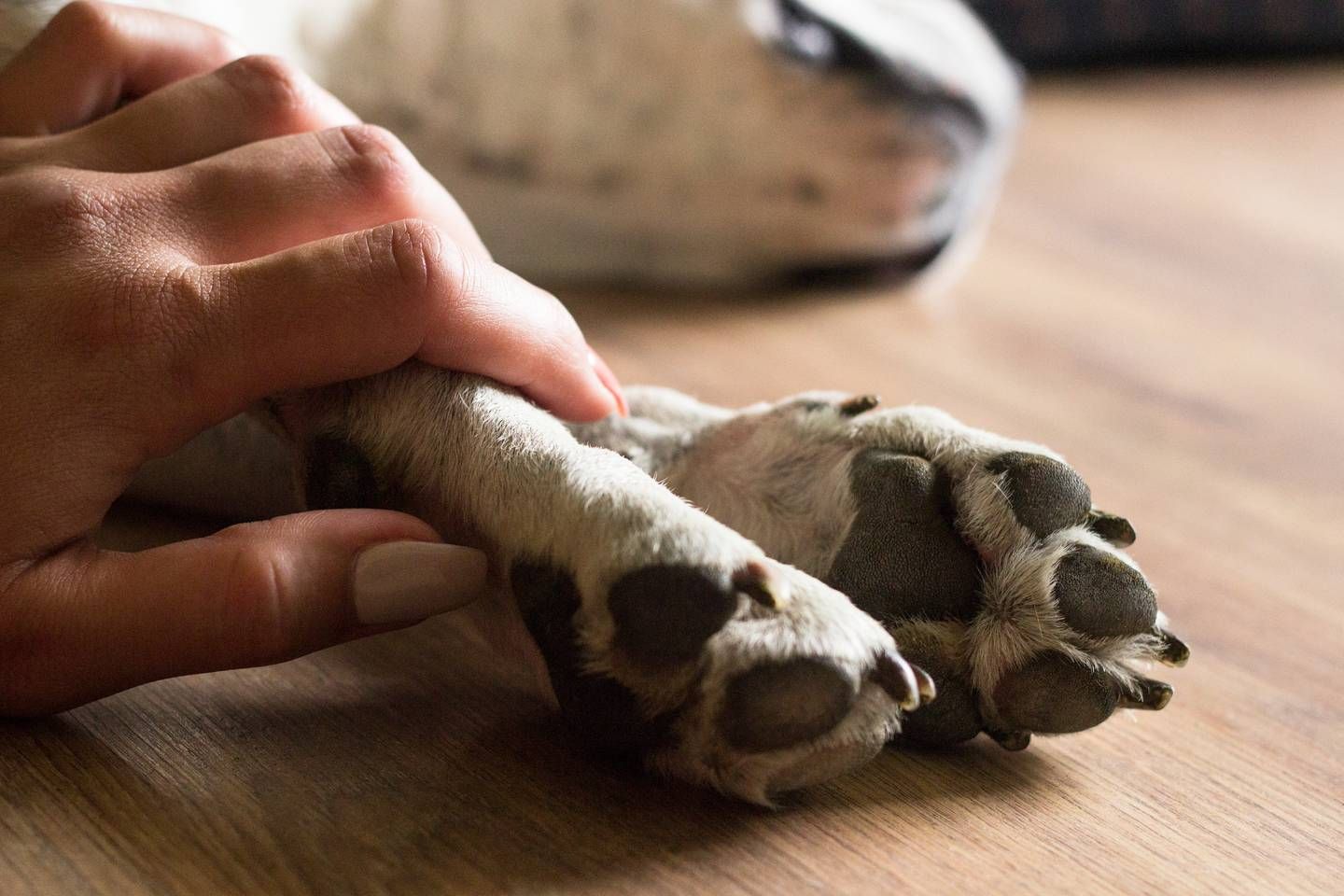– They can stick and shine on the wall, or become unclean. The latter is an important symptom, but is not one of the first.
That’s what veterinarian Jan Gravning at Fredrikstad Veterinærpraxis answers to Dagsavisen, when asked how a dog owner can tell if the dog is becoming demented.
It has been known for decades that dogs can get dementia. In medicine and research, the condition is called Canine cognitive dysfunction (CCD).
In humans, dementia is a collective name for several brain diseases, writes Helsenorge. The most common type is Alzheimer’s, where memory loss is the most common symptom.
Dementia in dogs has a similar course and symptoms, and is a cognitive disease that begins with mild symptoms. Once the dog has dementia, the symptoms will become more and more pronounced over time, just like in humans.
Veterinarian Jan Gravning at Fredrikstad Veterinary Practice. (Gry Catinka Wold)
Age-related disease
For dog owners, the symptoms that their dog has dementia can be difficult to see at first.
In some dogs, the only symptoms in the early stages are mild behavioral changes, such as barking for no apparent reason, beeping more than usual, or becoming more agitated when the owner is out of sight.
Veterinarian Jan Gravning has extensive experience of meeting dog owners who have older dogs with dementia symptoms.
– Not everyone knows that dogs can get dementia, he says.
– There has probably always been dementia in old dogs, but before it was perhaps just accepted that it got old and then they were eventually euthanized without it being discussed, he says.
Dog owners often come to the clinic because the dog has behavioral abnormalities.
– If the dog’s behavior has changed, they would like to have a solution. Sometimes the owners themselves suspect that they are becoming demented. It is not like we can take a test and prove that the dog is demented, so often we have to rule out other conditions. For example, if it has started to urinate inside, it is natural to check that there is not a problem with the urinary tract.
But changed behavior can also come from a brain tumor or metabolic problems.
– It can be very different. Therefore, we must try to exclude such things when it is an old dog.
Also read: – Dementia strikes like a disaster. You have an uninvited guest in your house
Varied symptoms
Behavioral change is the most typical symptom.
– Or they may seem disoriented, even in familiar surroundings. They can stick and shine on the wall, or become unclean. The latter is an important symptom, but is not one of the first. There is a big difference from dog to dog.
Some dogs do not recognize people they already know. Others experience anxiety symptoms.
– They can get separation anxiety and hang around the owner wherever they go. Or they may become less playful, passive, or stop grooming. Others may start with excessive licking, and they may change their circadian rhythm so that they sleep during the day and are restless at night. Some become aggressive. All these are typical signs, says Gravning.
Some dogs start acting up inside.
– They can pee outside, but then they pee inside right away because they have forgotten that they pee outside.
Because dementia is a progressive disease, the dog will have progressively worse symptoms.
– Dementia in dogs is not widely studied. It is assumed that there may be plaque in the blood vessels in the brain and changes in blood cells, which give less oxygen to the brain. It is hard to say. But what we do know is that it occurs in older dogs and that the repair processes do not go as they should. This results in a loss of brain cells, and this will get worse over time, Gravning explains.
– You have to be aware that if it goes too far, the dog can get fully developed dementia or Alzheimer’s where it doesn’t remember anything of what it has learned, and doesn’t even remember its owner.
Also read: The housing bubble we talk too little about
Man with dog autumn forest Dogs with dementia benefit from exercise and activities. (Chalabala/Getty Images/iStockphoto)
Size and age affect
At official exhibitions, the dog can be exhibited in the veteran class from the age of eight. Therefore, a dog is considered to be older from the age of eight. But according to Gravning, they can develop dementia much earlier.
– In large dogs, we can see dementia already from the age of five or six, then we are talking about the breeds that typically die when they are between seven and nine years old, he says.
In smaller dogs, dementia symptoms are rarely seen before the dog is around ten years old.
– Just like in humans, the symptoms will get worse over time. But dogs don’t live that long. Therefore, the development goes in a faster negative spiral, and it can go quickly when it first starts.
Although there is no cure for the disease, there are methods that can be used to keep it at bay and give the dog a good life.
– First and foremost, you should prevent, by being active with the dogs, teaching them things, and watching their weight so they don’t get fat. We know that if they are inactive, their cognitive abilities also decline, says Gravning.
Dogs with dementia benefit from being active and receiving exercise adapted to their age and general health.
– Exercise is good, but it is important to take account and adapt the training. Do not walk more miles with an older dog, because its health is not as it was when it was younger.
Although there are no medicines that will make the dog healthy, there are medical alternatives that can have an effect on the symptoms.
– There are some medicines that have a general effect that increases blood flow to tissues, including to the brain. It may help for some, and may delay development a bit. We can give anti-anxiety medication, if anxiety is the problem. And if it is an old dog that has joint pain, it can be given painkillers and anti-inflammatories to help it stay active.
If you have an older dog, it is recommended to start giving it special food for seniors from when they are seven or eight years old.
– It is special feed that has added ingredients that are positive for their health. Feeding older dogs is important, you have to feed according to age and activity, says Gravning.
– If you see symptoms of dementia, there is also feed with added substances that many believe can have a beneficial effect. But it’s good to be careful, because there is a jungle of products out there with supplements and things that don’t help. If you buy a feed intended for older dogs, it should be sufficient.
Also read: Wrote a book about life as a poor person: – Learned early on that it pays to keep quiet

Priceless moments The most difficult thing for a dog owner is to decide when the dog should be let go. (sanjagrujic/Getty Images)
The hardest choice
When your pet’s life is coming to an end, you as a pet owner have some tough decisions to make.
– It is always difficult to assess when to kill, says the vet.
– It is basically not illegal to grow old. If the dog is happy, eats, drinks, is content and lives a dog’s life, it must be assumed that it is doing well. But it’s always difficult. If you’ve had a great dog for twelve to fourteen years, where everything has been good, it’s not easy if it starts biting you or urinating down your house three times a day, says Gravning.
– It is a dilemma for people. If the dog eats, drinks and is happy, but destroys parquet and carpets – should you kill the dog because it pees on the floor? It is not easy for me to say where the line is. The assessment is always whether it is a good dog life or not.
Jan Gravning remembers one customer in particular, who often came in with an old dog.
– It worked fairly well, but every time the man wanted to talk about when we were going to euthanize it. Finally I asked if he was a doctor, as he was so concerned about it. No, said the man, I am a priest. It says something that he was also unsure, having worked with these questions of life and death all his life. It is not easy.
As a veterinarian, it is not his job to decide when the animal should be euthanized.
– I cannot make that decision if it is not completely obvious that the animal is suffering. But it might help the owner to decide if I say that if it were my dog, I would let it go. It can be helpful for the owner, but then I have to be honest about it, says Gravning.
– We are quite good at taking care of the situation if an animal has to be killed. The animal gets little, they feel a small sting from the injection, and after that, they fall asleep.
A 2017 study estimated that as many as 14–22 percent of dogs over the age of eight have CDC, and that the incidence increases exponentially with the age of the dog.
In 2022, another study showed that the risk of dementia increases by 52 percent for every year after the dog has reached the age of ten.
Also read: Kalle Moene: – The Left should simplify the welfare state (+)
—
Symptoms of dementia in dogs
- Is disoriented
- Less concerned with social interactions
- Changed sleeping pattern
- No longer the housekeeper
- Changed activity level
- Increased fear or aggression
- Reduced memory and ability to learn
Source: Hunomhund.no
—
Tags: symptoms dementia dogs Dagsavisen
-







